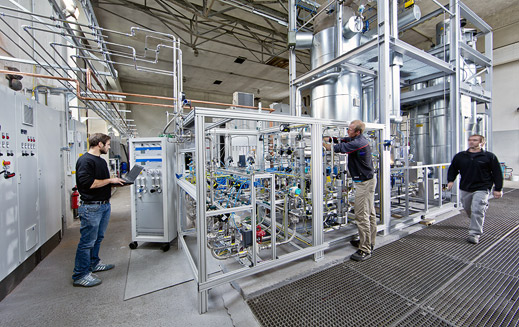Audi to Make Fuel Using Solar Power
Audi is building a plant that will use solar and wind power to make methane from water and carbon dioxide. The plant, which will use technology developed by Stuttgart, Germany-based SolarFuel, is scheduled to start operation later this year. It will produce enough methane to power 1,500 of Audi’s new natural-gas vehicles, which also go on sale this year.

SolarFuel’s process uses excess renewable energy generated as a result of Germany’s push to reduce greenhouse-gas emissions. There’s now so much renewable energy in Germany that supply sometimes exceeds demand—such as when the wind is blowing late at night. That power could be cheap enough to make methane from water and carbon dioxide, even though the process for doing so is inefficient.
SolarFuel says its approach may be a solution to one of the biggest challenges with renewable energy—its variability. Methane, which can be stored in existing natural-gas storage facilities, provides a convenient, long-term option for storing the energy.
To make the methane, SolarFuel combines two existing technologies. One is electrolysis, which splits water to produce hydrogen and oxygen. The other is methanation, which combines hydrogen with carbon from carbon dioxide to make methane. The company says its innovation lies in the way it’s combined the two processes.
SolarFuel’s chief customer officer, Stephan Rieke, says that the amount of excess renewable energy in Germany grew, in two years, from 150 gigawatt-hours per year to 1,000 gigawatt-hours per year. “That’s electricity that we could use for nothing,” he says. The amount is expected to continue to grow as Germany pursues ambitious goals to cut greenhouse-gas emissions 80 percent by 2050 using largely renewable energy (see “The Great German Energy Experiment”).
SolarFuel can’t compete directly with the wholesale price of natural gas. But it hopes to compete with biogas—methane produced from organic sources—a relatively large industry in Germany. It may also compete with retail natural-gas prices by building its plants close to consumers.
The uses of the technology outside of Germany—with its excess supply of cheap renewable energy—will be limited. The company is in talks with mining companies in Chile that currently get power from expensive diesel generation—its system could help such operations cut costs. The technology might also be attractive for rural communities without grid power (see “How Solar-Based Microgrids Could Bring Power to Millions”).
One major drawback of the process is its inefficiency. Its small-scale demonstration systems are only 40 percent efficient at converting electricity to methane. It hopes to improve that to 60 percent efficient in its commercial plants. Even then, when factoring in the losses from burning methane to generate electricity again, the overall process is at best 30 percent efficient. SolarFuel hopes to recoup much of that lost energy by using it for steam, but doing that is limited by the demand for steam and the infrastructure for distributing it.
Keep Reading
Most Popular
Large language models can do jaw-dropping things. But nobody knows exactly why.
And that's a problem. Figuring it out is one of the biggest scientific puzzles of our time and a crucial step towards controlling more powerful future models.
How scientists traced a mysterious covid case back to six toilets
When wastewater surveillance turns into a hunt for a single infected individual, the ethics get tricky.
The problem with plug-in hybrids? Their drivers.
Plug-in hybrids are often sold as a transition to EVs, but new data from Europe shows we’re still underestimating the emissions they produce.
Stay connected
Get the latest updates from
MIT Technology Review
Discover special offers, top stories, upcoming events, and more.